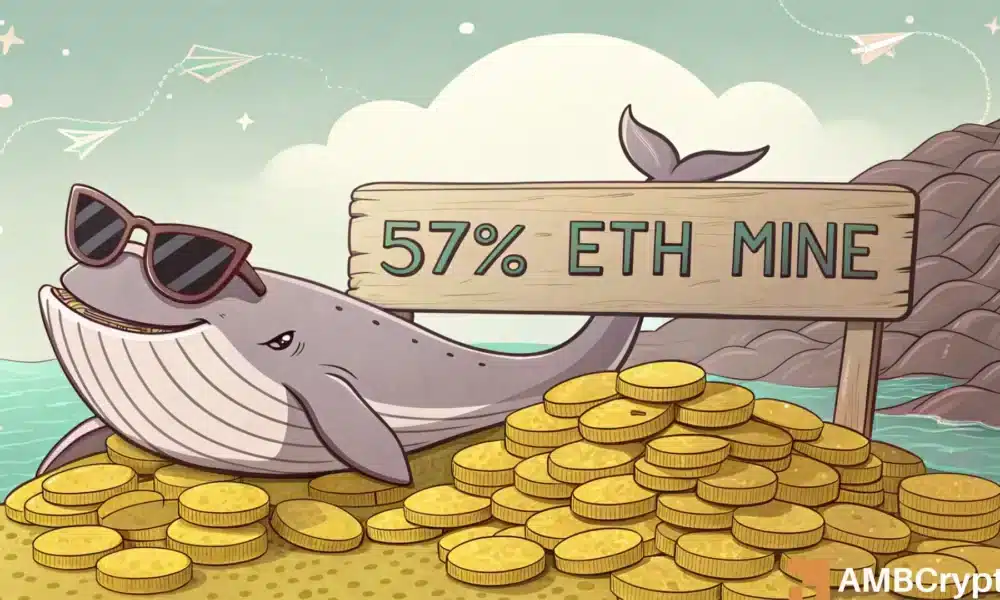Ethereum [ETH] whales are making significant waves in the market, with 104 wallets now holding over 100,000 ETH, representing more than 57% of the total supply. This shift in Ethereum’s distribution raises crucial questions about the future of the cryptocurrency, particularly in terms of market control and price movements. As these whales continue to accumulate ETH, their growing dominance signals strong bullish sentiment. However, the concentration of holdings also raises concerns about potential liquidity risks and market corrections.
Whale accumulation and long-term holders, often referred to as LTHs, play a crucial role in stabilizing the market during volatile cycles. These large investors strategically accumulate during market dips and hold onto their assets through periods of uncertainty. This approach has been reflected in Ethereum’s recent price rebounds and the rising whale transaction volumes exceeding $100k and $1M. Their actions align with Ethereum’s upward price trajectory in late 2024.
Despite the bullish sentiment driven by whale accumulation, there is a looming question about whether this trend is a bullish sign or a potential bear trap. While growing whale dominance indicates sustained confidence and positive momentum, it also amplifies the downside risk. A coordinated sell-off or a decrease in buying pressure could trigger sharp market reversals, highlighting the delicate balance between accumulation-driven optimism and the potential for a liquidity-driven correction.
Historical data on Ethereum’s whale activity reveals a strong correlation between whale transactions and price movements. Spikes in whale activity, especially those involving transactions above $1M, have often preceded significant price rallies or corrections. For instance, the surge in whale activity in late 2020 and early 2021 coincided with Ethereum’s monumental bull run, as whales strategically accumulated assets ahead of retail inflows. Similarly, rising whale activity during market consolidations in mid-2022 signaled accumulation phases that stabilized prices.
However, whale-driven peaks have also foreshadowed sell-offs, as witnessed during Ethereum’s pullback in 2022. This dual impact underscores the importance of monitoring whale behavior, as excessive concentration can introduce volatility if whales decide to offload their holdings, testing the market’s liquidity resilience.
Looking ahead, Ethereum’s whale-driven rally has propelled its price above the $4,000 mark, with strong buying volume reinforcing bullish sentiment. Technical indicators such as the Relative Strength Index (RSI) and On-Balance Volume (OBV) suggest further upside potential for ETH. If whale accumulation continues, Ethereum could target the $4,500-$5,000 range as its next milestone. However, the concentration of holdings remains a double-edged sword. While sustained accumulation fuels optimism, there is a risk of sharp corrections if whales decide to offload their positions, challenging liquidity and retail confidence.
In conclusion, the coming weeks will be critical in determining whether Ethereum’s rally solidifies or faces a potential reversal. Monitoring whale activity and market dynamics will be essential in navigating the evolving landscape of Ethereum’s price movements and market sentiment. The Origins and Evolution of the Internet
The Internet has become an integral part of our daily lives, connecting people from all corners of the globe and providing access to a vast amount of information and resources. But how did this revolutionary technology come to be? Let’s take a look at the origins and evolution of the Internet.
The concept of a global network of interconnected computers can be traced back to the 1960s, with the development of ARPANET. ARPANET, or the Advanced Research Projects Agency Network, was created by the United States Department of Defense as a means of sharing information and resources among researchers and scientists. The first successful connection was made in 1969 between the University of California, Los Angeles and the Stanford Research Institute.
Over the next decade, ARPANET expanded to include more universities and research institutions, laying the foundation for what would eventually become the Internet. In 1983, ARPANET adopted the TCP/IP protocol, which allowed different computer networks to communicate with each other, effectively creating the framework for the modern Internet.
The 1990s saw a rapid expansion of the Internet, with the introduction of commercial ISPs (Internet Service Providers) and the World Wide Web. The creation of the web browser, such as Netscape Navigator and Internet Explorer, made it easier for users to navigate the vast amount of information available online.
The early 2000s brought the rise of social media platforms like Facebook and Twitter, which revolutionized the way we communicate and share information online. The proliferation of smartphones and mobile devices further accelerated the growth of the Internet, making it accessible to people on-the-go.
Today, the Internet has evolved into a vast network of interconnected devices, with billions of users accessing it every day. From online shopping and social networking to streaming videos and playing games, the Internet has become an essential part of modern life.
However, with this increased reliance on the Internet comes challenges such as cybersecurity threats, privacy concerns, and the digital divide. As we continue to rely on the Internet for communication, information, and entertainment, it is important to ensure that it remains a safe and inclusive space for all users.
In conclusion, the Internet has come a long way since its humble beginnings as a research project in the 1960s. Its evolution has transformed the way we live, work, and interact with one another, and it will continue to shape the future of technology and communication for years to come.

